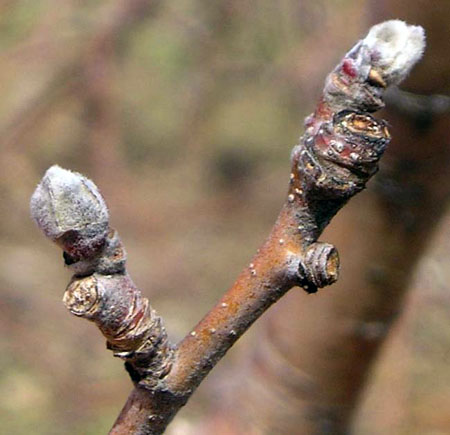Southwest Michigan fruit update
Fruit plantings are poised to renew growth when warm weather returns.
A cold Michigan winter hasn’t harmed Southwest Michigan’s fruit plantings. Plant growth has been stalled by the cold March, but should resume with warmer temperatures.
Winter’s coldest temperatures were on January 23 with lows near -16°F. These cold temperatures occurred during an extended cold period causing little damage and were recorded in lower freeze-prone areas. They probably caused no damage to cold sensitive fruits such as peaches and wine grapes, which are normally planted in high sites where the temperatures were closer to 0°F. Snow covered the ground for most of the winter. Warm weather in mid-March with highs near 70°F caused many plants to start growing. Unseasonably cold weather since then has stopped growth. The return of warmer weather next week should start growth again. Growers should expect little growth as long as highs for the day are below 40°F. Whenever lows drop below freezing at night the total amount of growth for the day will be low. Growers can access injury by taking cuttings of plants and bringing them inside. Buds that fall off were killed by the cold. As the flowers expand, examine the interior of the flower to see if they are black or brown, indicating damage.
There is still time to get dormant sprays on many fruit plantings. We are cooler than normal for this time of the season. You can check for a local weather station at: www.enviroweather.com.
Soils are beginning to dry. Now is a good time for applying soil active herbicides to control weeds.
Tree fruits
Most tree fruit buds are at first swell. At this stage, overnight lows of 15°F can cause some damage, but lows of 5 degrees or lower would be needed to cause severe damage to fruit flower buds. As fruit buds develop they become more susceptible to freezing injury.
Apricots are at swollen bud and the tips of the most advanced buds are opening.
Peaches are at first swell and past the dormant copper window to control peach leaf curl. There is still time to apply materials such as ziram or chlorothalonil to reduce leaf curl symptoms.
Sweet cherry buds are obviously swollen and well advanced. There is still time to apply copper to reduce bacterial canker. Tart cherries are less advanced but swelling is apparent on many buds. later in the season.
In plums, Japanese plums are well advanced at white side while European plums are at the beginning of bud swell. Black knotsymptoms are easy to see and the infected black swellings should be cut out to slow the spread of the disease. Spores are spread with rain and can infect new green tissue but the swelling canker symptoms do not become apparent until the next growing season.
Apples are at silver tip. The return of warm weather and plant growth will expose green tissue that will be susceptible to apple scab infection. Growers can use the scab infection tool on enviroweather at: www.enviroweather.com to track infection periods.

Photo 1. Silver tip in Jonathon apples.
Pears are beginning to swell and pear psylla should be out when warm weather returns.
Small fruits
Grapes are dormant and show no signs of growth.
Blueberries are generally dormant but flower buds of the early blooming varieties are moving. Applications of lime sulfur or Sulfurix now will help reduce phomopsis and anthracnose shoot blight later in the spring during rainy weather.
Strawberries have new leaves emerging from the crown. Now is a good to apply preemergent herbicides for early season weed control.
In brambles, black and red raspberry buds have begun to move and green tissue is showing. Blackberries are still dormant. Summer bearing plantings should be pruned back as soon as possible, if that has not already been done. Delayed dormant applications of lime sulfur will help reduce anthracnose in plantings were this disease is a problem.



 Print
Print Email
Email


